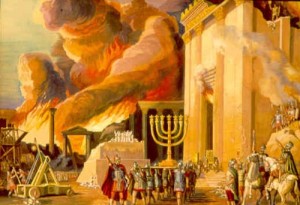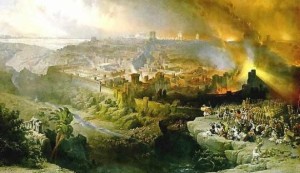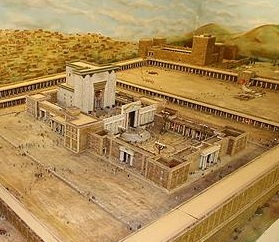Rock the House
Luke 6:47-49: A Preterist Commentary: Summary and Highlights
In the following Preterist commentary on Luke 6:47-49, Jesus tells a parable with a hidden end time message the meaning and fulfillment of which is explained below.
The following may seem unbelievable. However, all information is taken from unbiased historical records and is easily verifiable. Sources listed at the end.
Rock the House
47 As for everyone who comes to me and hears my words and puts them into practice, I will show you what they are like. 48 They are like a man building a house, who dug down deep and laid the foundation on rock. When a flood came, the torrent struck that house but could not shake it, because it was well built. 49 But the one who hears my words and does not put them into practice is like a man who built a house on the ground without a foundation. The moment the torrent struck that house, it collapsed and its destruction was complete.”
A Preterist Commentary on Luke 6:48-49: Floods represent Foreign Invaders. The Destruction of the House or Temple by the Romans signifies the Fulfillment of the Law.
Floods are often used in the Bible as a metaphor for an invading army (Isaiah 8:7-8; Daniel 11:10, 40; Nahum 1:8; Joel 2:9). See In the Bible “Earth” Signifies the Specific Land Addressed While “Sea” Symbolizes Foreign Nations. Similarly, the flood in Luke 6:48-49 symbolizes the Roman army and its assault on Israel from A.D. 66 to 74.1
The house mentioned in vs. 48-49 is the temple in Jerusalem, which Jesus predicted would soon be destroyed: “Look, your house [the Temple] is left to you desolate (Matthew 23:38).” Jesus was right, the Temple was, in fact, destroyed in A.D. 70. With the Temple in ruins it was no longer possible to carry out many aspects of the Law of Moses. As a result, Biblical Judaism had come to an end. The religion practiced by Jews today bears only a slight resemblance to the religion handed down by Moses. Called Rabbinic Judaism, this religion is a form of Judaism adapted to the destruction of the Temple. As stated above, the house built on the ground is the Temple in Jerusalem which represents the Law of Moses. The house built on the rock would not suffer the same fate. What is the house built on the rock?

Saint Peter. The rock in Luke 6:48 is the leader of the Christian church. In Daniel 2:45 and 1 Corinthians 10:4 the rock signifies Jesus, then Matthew 16:18 it represents Peter, the man entrusted to lead the church after Jesus’ death. “Peter” means “the rock.”
A Preterist Interpretation, Exposition and Commentary of Luke 6:48: The Rock is the Leader of the Christian Church.
Before answering this question, it is important to identify the rock in v. 48. This rock is the leader of the Christian church. In Daniel 2:45, this rock is Christ. In several places in the Bible including 1 Corinthians 10:4, Jesus is called “the Rock.” In Matthew 16:18 Jesus renames Simon, “Peter,” a name meaning “the rock”: “And I tell you that you are Peter, and on this rock I will build my church.”
A Preterist Commentary on Luke 6:48: The House Built on the Rock is Christianity.
Therefore the house built on the rock is Christianity. 2 Corinthians 6:16 says, “[W]e are the temple of the living God.” The house built on the ground represents the temple of stone destroyed at Christ’s return during the Jewish War. The house built on the rock represents the true temple of God. Unlike Biblical Judaism which came to an end at the destruction of Herod’s temple, the Christian church founded on Jesus’ teachings is a temple that will never be destroyed.

Herod’s temple was destroyed by the Romans in A.D. 70. This temple is the house built on the sand in Luke 6:49. The house built on the rock is the temple of the living God which according to 2 Corinthians 6:16 is the church.
A Realized Eschatological View and Commentary of Luke 6:47-49: The House may also be the House of Israel.
There may be another layer of meaning to this parable. The house in vs. 48-49 may also represent Israel. The kingdom of Israel is often called the house of Israel throughout the Bible (Psalms 135:19; Isaiah 46:3; 63:7; Jeremiah 2:4; Ezekiel 3:1). Therefore, the first house built upon the rock may be Christian Israel. The second house that is destroyed by the storm and flood is thus non-Christian Israel. The flood that collapses the second house represents the Roman army that destroyed apostate Israel in A.D. 70. Having fled to Pella, the Christian church was largely unmolested by the war. In the thousand years after the Jewish War, Judea grew to become 95% Christian by A.D. 614.2 Christian Israel represents the house built on the rock that withstood the war or storm.
**NOTE** This is a NEW website. If you liked this article share it, like us on Facebook and follow on Twitter. Thank You!
Interested in THE PRETERIST VIEW OF ESCHATOLOGY, or are you a PRETERIST struggling with a prophecy or verse? It DID happen just like the Bible says! If you liked this essay, see PRETERIST BIBLE COMMENTARY for a detailed explanation of the FULFILLMENT OF ALL MAJOR END TIME PROPHECIES IN THE BIBLE. The more unbelievable the prophecy, the more amazing and miraculous the fulfillment!
Also see Historical Evidence that Jesus was LITERALLY SEEN in the Clouds in the First Century. For an explanation of how the end of the age and its fulfillment during the Jewish War mirror Genesis 1-3; how the Bible teaches that the resurrection of the dead is a resurrection of heavenly bodies to heaven, not a resurrection of perfected earthly bodies; and how the resurrection is a mirror opposite of the fall see How the Jewish War and Resurrection to Heaven Mirror Genesis and the Fall; and How Preterism fixes the Age of the Earth Problem and unravels the Mysteries in Genesis.
Luke 6:47-49: A Preterist Commentary: Conclusion
In this Preterist commentary on Luke 6:47-49, Jesus tells a prophetic parable whose meaning and fulfillment points to the Jewish War and its aftermath.
Luke 6:47-49: A Preterist Commentary
- This flood also represents Hades. There is also a deeper layer of meaning to this parable concerning the conquering of death through Christ. See The Poetic Biblical Link Between “Sea” and “Abyss”.
- Thomas A. Idinopulas, Jerusalem Blessed, Jerusalem Cursed: Jews, Christians, and Muslims in the Holy City from David’s Time to Our Own (Chicago: Ivan R. Deer, 1991), 102.







As for the leader of the church, Peter as you said, being the rock I have to disagree. First, James the half brother of Jesus was the leader of the church. Secondly, the “rock” that Jesus called Peter, means a pebble, while the rock that Jesus said the church would be built on means a boulder, or mountain.. Therefoee Jesus said. The church would be built on Him, not Peter, as only the Word of God can build a real church.
Thank you for your insight James. Let me clarify. Of course Jesus is the ultimate rock upon which the church is built; however, who were the people who were right there with Jesus at the inception of the church? The disciples of course! Thus confirming the fact that the disciples alongside Christ are the rock that forms the foundation of the church Revelation 21:14 says that the wall of teh New Jerusalem has 12 foundation stones which are the 12 disciples. Jesus also forms that foundation as Jesus is called the chief cornerstone in the NT, the ceremonial first stone placed on a building’s foundation.